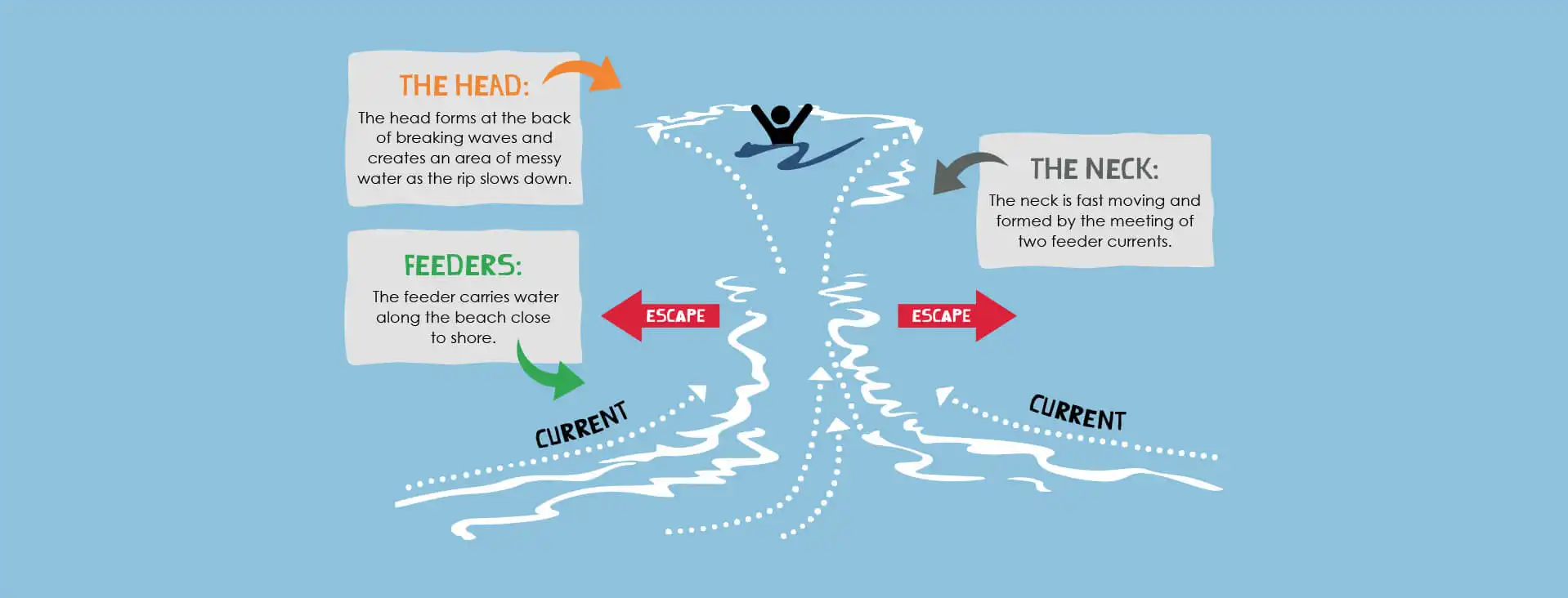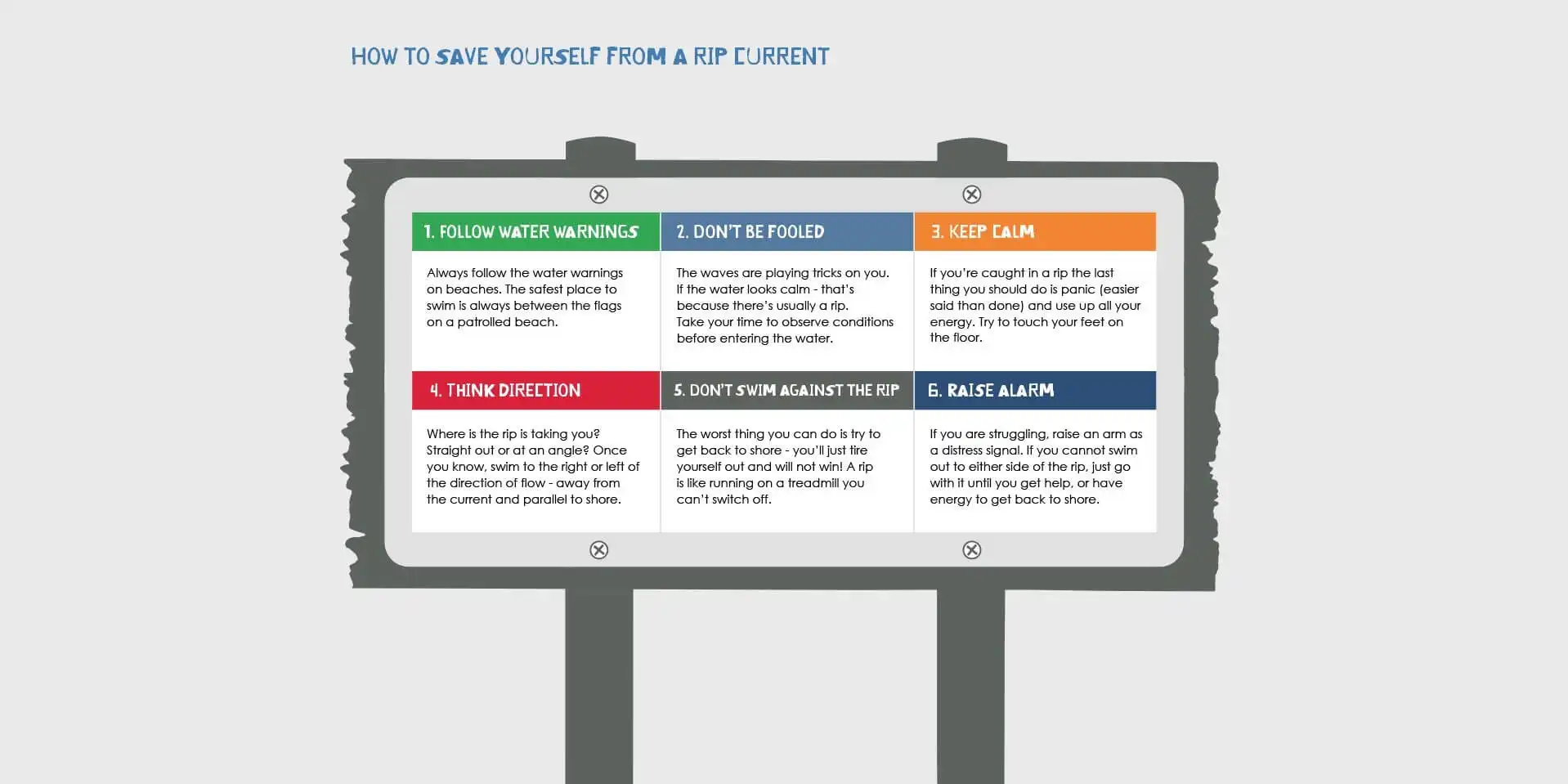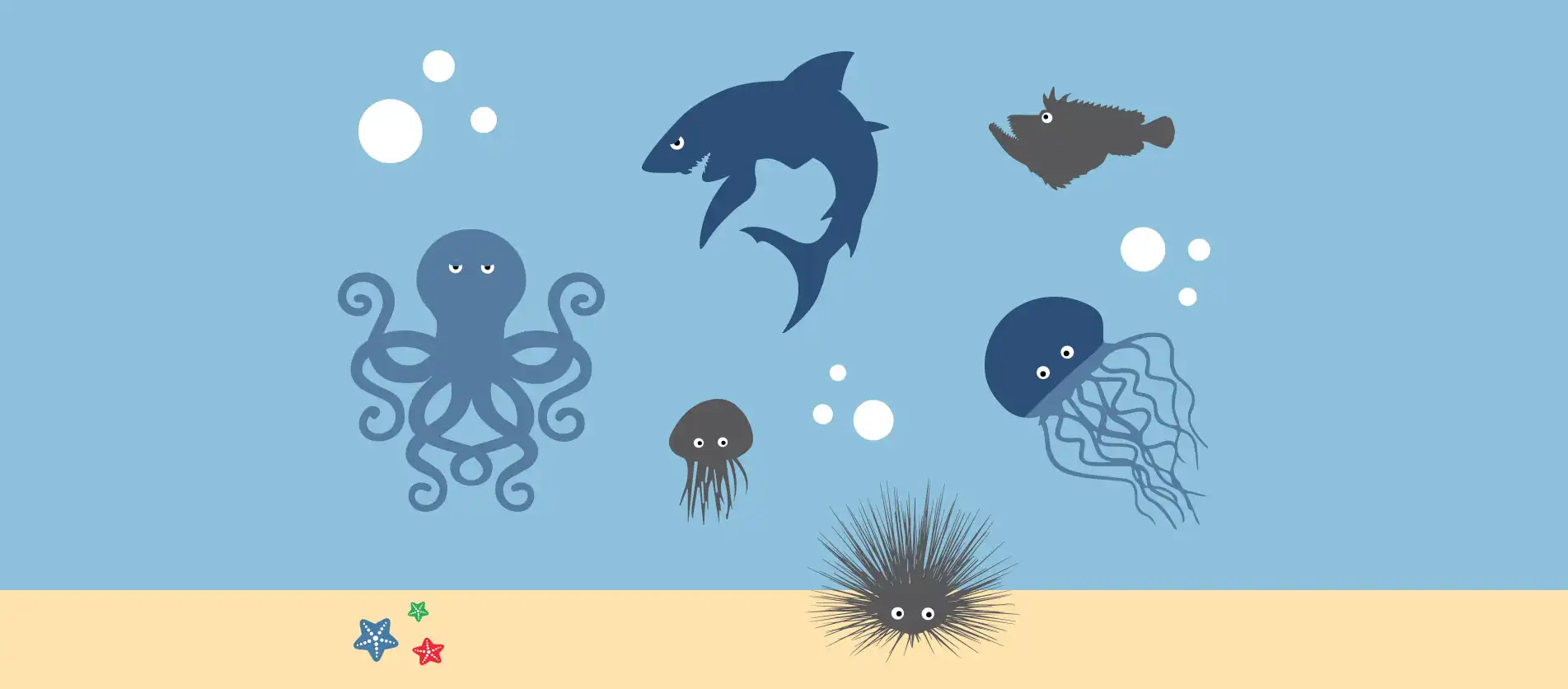We’re a water loving nation! Well it’s hard not to be when you live on a (very large) island surrounded by coastline and almost 11,000 beautiful beaches.
For years the sun, sea and sand has attracted millions of people to our glorious shores. Australia's beaches are revered: Bondi, Byron Bay and Wineglass Bay are visited by countless tourists each year while remaining firm local favourites. From Saturday morning surf-club training to brisk ocean dips and festive beachside bbq's, our staple weekend activities are rarely far from our warm sandy shores.
However, as inviting as our waters may be, it's important to remember that what lies beneath those majestic seas is unpredictable. Our beach safety guide will run you through the essential facts you'll need visiting the beach.
Without meaning to dampen your spirits- we'll take you through some of the more commonly understood dangers of our Aussie beaches. Then onto the meaty stuff - riptides; how to spot them, the different types of rips and what to do when you're caught in one. Plus we'll throw out some useful beach smarts that are worth getting into your noggin!
Does Australia's watery wildlife give you the heebeegeebees? We tell you what to watch out for when you go for a swim. And if that isn't enough we'll also fill you full of facts and stats. So water you waiting for....dive right in!
Water facts: true or false?
True: Only 15% of Australians live inland while most live within 50 kilometres of the coast, making our shorelines an integral part of our wet and wild lifestyle.
False: Only 4% of beaches are currently patrolled. With 11,000 beaches, there's only so many lifeguards to go around!
False: One person will drown every two to three days during Australian summers. 90% of those fatalities will be rip-related.
False: Approximately 17,000 rips occur in Australia oceans at any given moment.
False: Rips cannot pull people vertically underwater. Rather, rips pull you out and off shore.
False: Rips can pull even the strongest of swimmers out to sea. In fact, rips can move three times faster than an Olympic swimmer!
False: Many people end up in a rip current that resembles a calm patch of water. This can disguise a path of turbulent, stormy waters and can drag in an unassuming swimmer in a flash.
False: The worst thing you can do is to fight those fierce currents. You’ll just tire yourself out and will not win! Swim parallel to shore until you’re out of the rip.
False: 271 people drowned in Australian waterways between 1 July 2014 and 30 June 2015. 80% of those were male.
Rip tides
So what exactly is a rip? Essentially, the best way to picture it is much like a river running back out to sea. When a series of waves come rushing to the beach (or a sandy sea bed) all that water must flow back out somehow. It does this by flowing back under the breaking waves and forming a deep channel of water – known as a rip tide.

How to spot a rip
Oddly enough, a rip is usually the area at shore that appears safest. Rips are occasionally characterized by their darker and deceptively calm waters. Contrastingly, a rip can also appear milky or turbulent but it is almost always devoid of strong wave activity.
When trying to spot a rip, look for a semi-circle like indentation on the shore which might imply a washout, waves crashing against the shore at an angle or heavy surf conditions.

The different types of rips
FIXED RIPS: Fix rips are the ones you’re most likely to come into contact with regularly as they tend to stick around in the same location (as the name suggests). They are usually formed when small waves bring lots of sand back up to the beach. Their shape and size can change depending on the surf.
FLASH RIPS: Heard of flash floods? Same thing happening here. Flash rips tend to occur suddenly when weather conditions turn treacherous during storms. These rips are particularly powerful and can extend from 10- 100 metres out into the surf.
TOPOGRAPHIC RIPS: As the name suggests, these rips occur because of the arrangement of natural or artificial features of the beach such as headlands, sand banks or man-made barriers.
MEGA-RIPS: These are the daddy of all rips! You don’t want to find yourself caught in these bad boys, believe us. Mega rips are driven by deep currents that mature during times of severe wave activity. Luckily, most people don’t find the water too appealing in conditions like these, so you don’t hear of many incidents relating to mega rips.
To find out whether your chosen beach is subject to rips check out our interactive Aussie beach tool.

Beach smarts
Keeping safe at the beach and in the water requires common sense and knowledge so you can be aware of the hazards and dangers you may face. While the beach can be a source of immense joy and beauty, keeping some basic safety signals in mind can literally mean the difference between life and death. When stingers, rips, or even sharks come within close proximity, it's vital to understand the danger signs. We run through some basic beach smarts to keep you safe at sea.

RED & YELLOW FLAGS: These are the flags put up by lifeguards showing you where it’s safe to swim. They are there for a reason, so use common sense and swim in between them.
BLACK & WHITE FLAGS: No swimmer or surfer wants a case of wave collision – in the worst case scenario this can cause serious injuries. The black and white flags are there to point out 'no surf zones' and areas that are relegated specifically for swimmers.
WARNING SIGNS: You’ll typically find these type of signs near the entrance to the beach warning you of any common hazards to pay attention to.

REGULATORY SIGNS: Regulatory signs which are put up by the local government warn visitors of any forbidden activities such as windsurfing or swimming due to rough conditions. Beware- you could be fined if you do not obey them!
INFORMATION SIGNS: These outline any available facilities and permissible activities such as bbqs, toilets, showers, bodyboarding etc.
SAFETY SIGNS: These signs show what type of safety aids can be found at your beach. These can include services such as surf patrols, emergency beacons, public rescue equipment or first aid.
Australian water wildlife
Whether you’re snorkelling the stunning sights of the great barrier reef or discovering the wonders of your local beach you're bound to encounter some form of marine life. Australia's waters are home to the world’s largest reef system, over 5,000 species of fish,1,700 different species of coral, 170 types of sharks, 45 types of whale, dolphin & porpoise species, 32 types of seas snakes ...and that's just for starters!
Our wildlife has a reputation for being the most diverse in the world. There's no denying that Aussie waters contain some of the most beautiful life forms going on, but also some of the deadliest.
Marine life can have unique defence mechanisms including stinging, biting, puncturing, poisoning and even chemically attacking their prey. These can be potentially lethal to humans so it's essential to maintain vigilance when you're entering the underwater world.
As a general rule-of-thumb, don’t touch anything beneath the ocean's surface. This one's a biggie not just for your safety, but to preserve the natural environment of all marine species. Remember that we are merely guests in their big blue sea.
Keep reading to find out what watery wonders you might encounter in the Aussie waters.

BLUEBOTTLE: The Blue Bottle, also known as the Pacific Man o' War, is the most common jellyfish in Australia. They are often found floating about in large groups and tend to wash up on shores in huge numbers too. Bluebottles stings can be nasty, but not particularly dangerous. The sting from their long blue tentacle can last a while, but the pain can typically subside in a few hours. TREATMENT: If you're stung, get out of the water and carefully remove any remaining tentacles (preferably with gloves). Try not to touch the area affected to avoid further stings. After a major sting it’s always a good idea to check-in with the lifeguards on the beach - especially if you develop further symptoms such as vomiting, continuing pain, or itchiness.
BLUE RINGED OCTOPUS: If looks could kill! The blue-ringed octopus's beautiful colours may have you entranced but beware as these majestic creatures can be deadly! Most commonly found in the shallows, these can be difficult to spot due to their seamless camouflage. The blue-ringed octopus' bite is usually painless, however, numbness of the mouth, feelings of weakness and difficulty breathing can occur rapidly in victims. Bites left untreated may even lead to death. TREATMENT: Contact emergency services (000) immediately and proceed with CPR if necessary. Apply pressure to the area affected.
IRUKANDJI JELLYFISH: The venom of this tiny creature is said to be 1000 times more powerful than that of the cobra! The Irukandji jellyfish can be found from north Queensland through to Western Australia from November to March. If you see one of these in the water, get out quick smart! Irukandji jellyfish measure just 5mm with a box-like squarish bell with stingers and hollow tentacles coming from each of the four corners. TREATMENT: Luckily, the effect of a sting can take days before they are felt. If you are stung it's best to head to the hospital as soon as possible. The best prevention is to wear a stinger suit at all times during jelly season,
BOX JELLYFISH: These are considered to be the deadliest jellyfish known to man with enough venom to kill 60 adult humans! The sting of the box jellyfish has been compared to being branded with a red hot iron and victims can often drown from the shock of the pain alone. Pale blue and transparent in colour, Box jellies have a cube-like, bell shape and tentacles that can reach to three meters in length. TREATMENT: Time is not on your side – the box jellyfish can cause death in a healthy adult in minutes. if somebody is stung they need to get to hospital fast, so call an ambulance as soon as possible. If available, vinegar can be applied to tentacles to deactivate the sting.
CONE SNAILS: Geography and Textile cones are both large types of snail that live on sand, rubble or under rocks. They are found from north Western Australia to southern Queensland. They prey on fish and are highly venomous, so if you see one and you get the urge to pick it up, just don’t! Treatment: Quick response is vital, get someone to call an ambulance fast if you have been stung. Try not to move the area affected to stop the spread of the poison.
FIRE CORALS: Although known mainly as stinging or fire corals, these organisms are in fact closer related to the jellyfish or other stinging anemones. They have a bright yellow-green and brown skeletal covering and are found in tropical waters. They are not deadly but the sting will certainly cause pain, a red rash and itching. Treatment: Rinse with seawater, not freshwater which will increase pain. Remove any parts of the fire coral with tweezers and try not to move area affected.
SALT WATER CROCODILE: Found in northern Australia, this huge endangered reptile is not to be messed with. People most at danger of being attacked are those who are swimming in areas they shouldn't be. So, if you see signs or have been told it’s a no-go zone, make sure you listen! Treatment: These predators are incredibly strong, If you are attacked by a salt water croc, it’s likely you’ll be suffering from severe injuries. Call for help and immediate transport. Maintain open airway, be mindful of possible neck injury, direct pressure over bleeding wounds. Keep warm and treat for shock as needed.
SEAFERNS: Common in the Great Barrier Reef, these feathery ferns can reach anywhere up to 450 mm high. Although they may look pretty, they can cause a painful sting which rashes, burns or blisters. Treatment: Similarly to fire corals (or any types of stinging hydroids), rinse with seawater or vinegar if available. Clean the area and add a calming lotion.
SEA SNAKES: There are 32 types of sea snake in Australia; from the banded sea snake with its black and white rings to the bright yellow-bellied. They have paddle-like tails for swimming and valves over their nostrils which close underwater. Sea snakes are actually way more toxic than land snakes, however they pose little risk as they're so scared of humans and stay well away. If you are bitten you may not notice pain immediately, however, after a short time you will feel stiffness, muscle aches and moderate to severe pain in the affected area. Treatment: As with any poisonous bite, get to a hospital fast. Treat for respiratory failure and start CPR if necessary. Anti-venom should be given as soon as possible.
SEA URCHINS: You're most at risk of hurting yourself or stepping on a ski urchin when you’re snorkelling around reefs or exploring rock pools. Sea urchins are not poisonous but getting one of their black spikes in your foot ain't gonna be pretty! Treatment: Remove any spikes with tweezers, disinfect the area and bandage if necessary.
SHARKS: Sharks certainly have a scary perception attached to them here in Australia, however it's a fact that more people actually die from selfie-related injuries than they do from shark attacks! Regardless of how low the risks, it’s not to say the dangers aren’t real. There are three types of sharks that are considered dangerous out of the 160 species that live in our Aussie waters - the Great White, the Tiger shark and the Bull shark. Treatment: Depending on the severity of your injuries it’s pretty obvious that you’re going to need to get to a hospital quick smart. If you’ve been bitten, try and get out of the water, put pressure on the wound and get someone to call 000.
STONEFISH: Stonefish are found living among coral reefs all around Australia. As the name suggests, they are camouflaged to look like stones or rocks on the sea bed. These obscure little rippers have spines along their back that release a venomous toxin. As always recommended when exploring the underworld, do not touch anything and wear protection on your hands and feet when snorkelling. Treatment: If you've been stung, when you are out of the sea hot water can be used on the area to relieve some of the pain. Make sure somebody calls 000 straight away. It’s recommended to be given stonefish anti-venom as soon as you reach hospital.
STINGRAY: In Australia there are about 50 species of rays; 21 types living in the coastal waters of Queensland. Most are found on the seabed, on sandy muddy areas. They have tails armed with spines and may release a spine with venom when agitated. They are not usually aggressive, but the stingray may use its stinger in self-defense when accidentally stepped on. Although painful, stingray wounds are rarely fatal. Most injuries caused by stingrays are not due to venom intoxication but rather from internal organ injury. Treatment: Seek immediate medical attention. Depending on where the person has been stung, treat the wound, or for shock, or for allergic reaction in order of priority. You can use hot water on the area to alleviate pain.
Please note, this is not a definitive list of all Australian marine life.
How to prevent bites & stings
- Swim at patrolled beaches: Especially between the designated red and yellow flags
- Follow warning signs: Don’t enter the water when the beaches are closed or have danger alerts
- Use protection: Wear a full-body stinger suit, especially in stinger season
- Avoid contact: Stingers and water wildlife may be interesting and intriguing, however it's important to not touch
- Go slow: When entering the water, do so cautiously giving any marine life time to swim away. Remember they are more scared of you, than you are of them!
- Seek help: Always ask a lifeguard for beach advice before entering the water
Useful links
Sources

Natalie Smith
Having travelled to over 40 countries, studied tourism management and worked as a flight attendant for over three years, Natalie knows more than a thing or two about travel! She’s an adventure-lover, whose favourite trips have been trekking Machu Picchu and volunteering in an animal shelter in the Amazon. Qualified in Tier 2 General Insurance General Advice and specialising in travel insurance for the last five years, she in passionate about helping travellers get the most out of their holiday.








